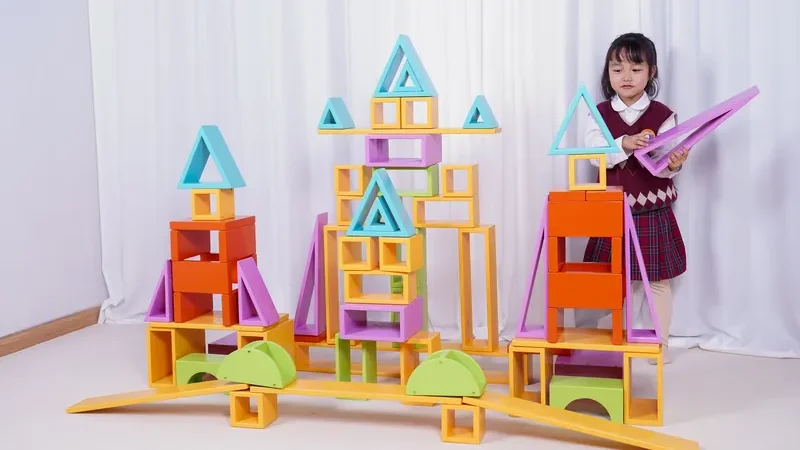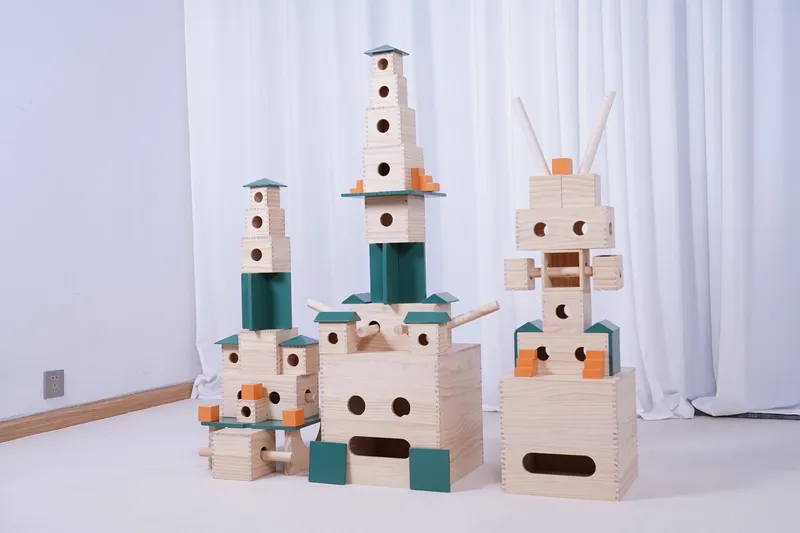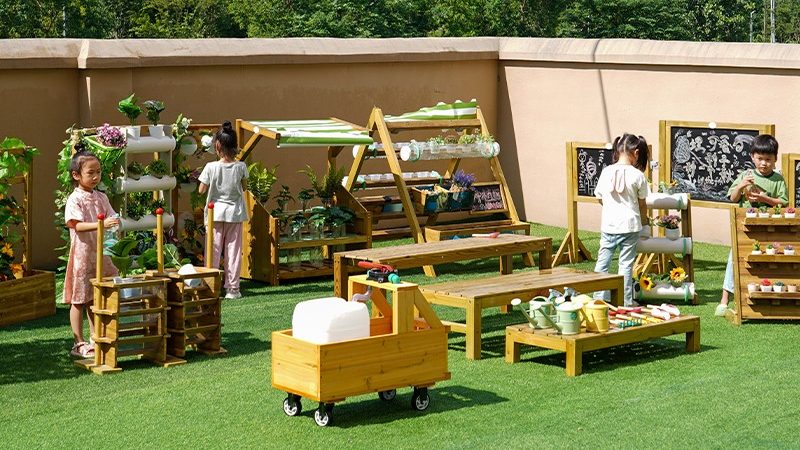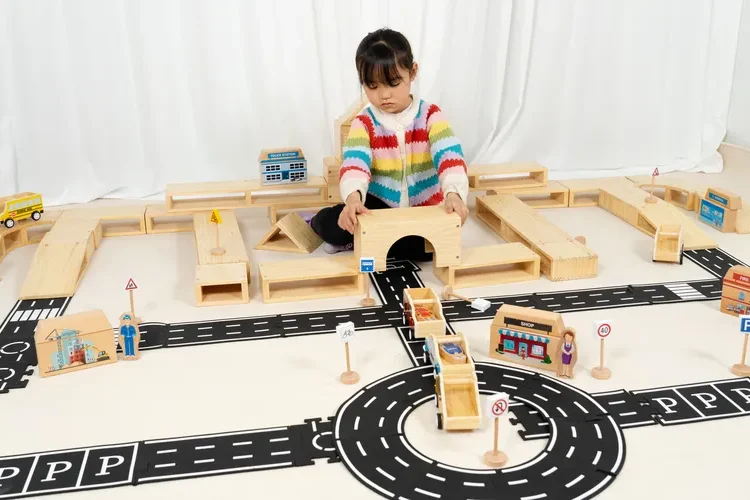How to clean wooden blocks is one of the most common questions we receive from kindergartens, educational institutions, and parents worldwide. As a leading manufacturer of educational wooden toys, we understand that maintaining the hygiene and longevity of wooden block toys is essential for creating a safe learning environment for children.
Wooden blocks have been cherished educational tools for generations, fostering creativity, problem-solving skills, and motor development in young learners. However, these beloved toys require proper care to remain safe, clean, and durable for years of educational play.
Table of Contents
- Why Wooden Blocks Need Special Cleaning Care
- Understanding Wood’s Natural Antimicrobial Properties
- Essential Supplies for Cleaning Wooden Toy Blocks
- Step-by-Step Guide: How to Clean Wooden Blocks
- How to Wash Wooden Blocks in Educational Settings
- Cleaning Wooden Block Toys: What to Avoid
- How to Disinfect Wooden Toy Blocks Safely
- Maintaining and Conditioning Your Wooden Blocks
- Frequency Guidelines for Different Settings
- FAQ: Common Questions About Cleaning Wooden Blocks

Why Wooden Blocks Need Special Cleaning Care
Wooden blocks differ significantly from plastic toys in their composition and care requirements. Understanding these differences is crucial for anyone wondering how to clean wooden toy blocks effectively.
Wood is a porous, natural material that absorbs moisture differently than plastic or metal. This unique characteristic means that wooden toys require gentle cleaning methods that preserve their integrity while ensuring proper hygiene.
In educational settings, children frequently handle blocks with unwashed hands, drop them on floors, and sometimes even put them in their mouths. These behaviors make regular cleaning essential for preventing the spread of germs and maintaining a healthy learning environment.
According to the Centers for Disease Control and Prevention, toys with porous surfaces like wooden blocks should be wiped with a cloth soaked in warm soapy water rather than submerged, as excessive moisture can damage the wood structure.
Understanding Wood’s Natural Antimicrobial Properties
One of the remarkable advantages of wooden educational toys is their inherent antimicrobial properties. Scientific research has demonstrated that wood naturally inhibits bacterial growth, making it a superior choice for children’s toys.
Studies from the American Chemical Society have shown that wood possesses natural antiviral properties that can reduce the time viruses persist on its surface. This occurs because wood’s porous structure draws moisture away from bacteria and viruses, creating an inhospitable environment for microbial growth.
When learning how to clean wooden blocks toys, it’s important to understand that you’re working with a material that already has some built-in protection. However, this doesn’t eliminate the need for regular cleaning—it simply means you can use gentler, more natural cleaning methods.
The antimicrobial action occurs through several mechanisms:
- Wood fibers absorb bacteria into the material
- Trapped bacteria die from lack of moisture and nutrients
- Natural compounds like tannins and lignans actively inhibit bacterial growth
- The porous structure prevents surface contamination
Essential Supplies for Cleaning Wooden Toy Blocks
Before you begin cleaning your wooden blocks, gather these simple, child-safe materials:

Basic Cleaning Supplies:
- Soft microfiber cloths (2-3 pieces)
- Warm water
- Mild dish soap or castile soap (1-2 drops)
- Spray bottle for cleaning solution
- Soft-bristled brush (for hard-to-reach areas)
Natural Disinfecting Options:
- White vinegar (creates a 1:10 ratio with water)
- Apple cider vinegar (alternative to white vinegar)
- Baking soda (for stubborn stains)
Maintenance Supplies:
- Food-grade mineral oil or olive oil
- Natural beeswax (for conditioning)
- Clean, dry towels for air drying
All these supplies are non-toxic, environmentally friendly, and safe for use around children. This is particularly important in educational settings where safety standards are paramount.
For bulk orders of educational wooden blocks for your institution, explore our wooden block sets for kindergartens that come with complete care instructions.
Step-by-Step Guide: How to Clean Wooden Blocks
Follow this comprehensive method to clean your wooden blocks effectively while preserving their quality and finish.
Daily Light Cleaning (Routine Maintenance)
Step 1: Dust Removal Begin by using a dry microfiber cloth to wipe away surface dust and dirt from each block. This prevents dirt from being spread during wet cleaning.
Step 2: Prepare Cleaning Solution Mix 1-2 drops of mild dish soap in a bowl of warm water. For vinegar solution, combine 1 part white vinegar with 10 parts water in a spray bottle.
Step 3: Damp Wipe Method Dampen (not soak) your cloth in the cleaning solution. Wring it out thoroughly until it’s just barely moist. Gently wipe each wooden block, paying attention to all surfaces.
Step 4: Remove Soap Residue Use a separate clean, damp cloth to wipe away any soap residue. This step is crucial as soap residue can attract dirt and may be harmful if children put blocks in their mouths.
Step 5: Air Dry Completely Place blocks on a clean, dry towel in a well-ventilated area. Allow them to air dry completely before returning to storage or play areas. This typically takes 2-4 hours depending on humidity levels.
Deep Cleaning (Weekly or As Needed)
When blocks show visible dirt or after illness outbreaks in your facility, follow these enhanced cleaning steps:
For Multiple Blocks: Fill a sink or basin with cleaning solution (1 part soap to 4 parts warm water). Briefly dip blocks in the solution—this is a quick dip, not a soak! Swirl for 5-10 seconds maximum, then immediately drain, rinse with clean water, and dry thoroughly.
For Stubborn Stains: Create a paste using baking soda and water. Apply to stained areas using a soft cloth or brush. Gently scrub in circular motions, then wipe clean with a damp cloth and dry immediately.
How to Wash Wooden Blocks in Educational Settings
Kindergartens, daycare centers, and schools face unique challenges when maintaining wooden toys. High usage rates and multiple children handling the same toys require a systematic approach to hygiene.
Establishing a Rotation System
Professional childcare providers often maintain multiple sets of blocks, rotating them daily. This allows one set to be cleaned and dried thoroughly while another set is in use. This system, recommended by experienced daycare professionals, ensures blocks are never rushed back into use before completely dry.
Following Institutional Guidelines
According to the New York City Department of Education guidelines, toys with porous surfaces like wooden blocks cannot be submerged or soaked in cleaning solutions. Instead, they should be wiped with a cloth soaked in warm soapy water to remove debris, then sanitized using approved methods.
Bulk Cleaning Methods for How to Clean Wooden Blocks Toys
For large quantities of wooden blocks in institutional settings:
- Sort blocks by size and condition before cleaning
- Inspect for damage – set aside any blocks with splinters or cracks
- Use spray bottles for efficient application of cleaning solution
- Implement assembly line method – one person sprays, another wipes, another dries
- Sun-drying station – arrange blocks in sunlight for natural disinfection and faster drying
The UV rays from sunlight provide additional germicidal benefits. However, monitor exposure time to prevent fading of painted or stained blocks. Generally, 15-30 minutes of indirect sunlight is sufficient.
Documentation and Scheduling
Maintain a cleaning log to track when blocks were last cleaned. This is particularly important for meeting health and safety regulations in licensed childcare facilities. Many institutions clean high-touch toys daily and conduct deep cleaning weekly.
Cleaning Wooden Block Toys: What to Avoid
Understanding what NOT to do is just as important as knowing the proper cleaning methods for how to clean wooden toy blocks.

Never Soak or Submerge Wooden Blocks
This is the golden rule of wooden toy care. Prolonged water exposure causes wood to:
- Absorb excessive moisture and swell
- Warp or change shape
- Develop cracks as it dries
- Lose paint or finish
- Create conditions for mold growth
Even water-resistant wooden toys should only experience brief contact with water during cleaning.
Avoid Harsh Chemical Cleaners
Never use these products on wooden blocks:
- Bleach – damages wood fibers and can leave toxic residue
- Disinfectant wipes – contain chemicals unsafe for children
- Furniture polish – creates toxic film that children may ingest
- Alcohol-based cleaners – dry out and crack wood over time
- Ammonia-based products – too harsh for wood surfaces
Don’t Use Dishwashers or Washing Machines
While tempting for convenience, dishwashers expose blocks to:
- Excessive heat that cracks wood
- Too much water causing swelling
- Strong detergents that strip finishes
- Pressure that can damage delicate pieces
Similarly, washing machines are far too aggressive for wooden toys.
Avoid Rapid or Artificial Drying
Never attempt to speed up drying using:
- Hair dryers (heat causes cracking)
- Heating vents or radiators (uneven drying leads to warping)
- Direct intense sunlight for extended periods (causes fading and splitting)
Patience is essential when drying wooden blocks. Rushing this process compromises the wood’s integrity.
How to Disinfect Wooden Toy Blocks Safely
While regular cleaning removes most dirt and germs, certain situations require additional disinfection, especially when learning how to wash wooden blocks after illness outbreaks.
When to Disinfect Wooden Blocks
Disinfection is necessary when:
- A child has been sick with contagious illness
- Toys have been contaminated with bodily fluids
- Following health department recommendations
- After being stored in damp conditions
- When transitioning between different groups of children
Natural Vinegar Disinfection Method
Vinegar is an effective, child-safe disinfectant for wooden blocks:
Standard Solution: Mix 1 part white vinegar with 4 parts water
Strong Solution: For enhanced disinfection, use 1 part vinegar to 2 parts water
Application Process:
- First clean blocks with soap and water
- Spray or wipe vinegar solution on all surfaces
- Allow to sit for 2 minutes
- Wipe with clean, damp cloth to remove vinegar smell
- Air dry completely
Sanitizing Solutions for Educational Institutions
Many licensed facilities must follow specific sanitizing protocols. According to professional daycare cleaning standards, approved sanitizing solutions should be:
- EPA-registered for childcare use
- Non-toxic when dry
- Appropriate for porous surfaces
- Applied according to manufacturer instructions
Always verify that any commercial sanitizer is approved for use on wooden surfaces and safe for children’s toys.
Sunlight as a Natural Disinfectant
Ultraviolet light from the sun naturally kills many pathogens. After cleaning wooden blocks:
- Place in indirect sunlight
- Allow 15-30 minutes of exposure
- Turn blocks to expose all sides
- Avoid extended exposure to prevent fading
This method works particularly well for natural, unstained wooden blocks and provides a chemical-free disinfection boost.
For institutions seeking sustainable, eco-friendly toy options, explore our natural wooden block collections designed with minimal finishes for easy cleaning.

Maintaining and Conditioning Your Wooden Blocks
Proper maintenance extends the lifespan of wooden educational toys significantly. This is an often-overlooked aspect of how to clean wooden blocks toys that ensures long-term durability.
Why Wooden Blocks Need Conditioning
Just like wooden cutting boards, wooden toys benefit from periodic oiling to:
- Replace natural moisture lost during cleaning
- Prevent wood from drying out and cracking
- Maintain smooth surfaces for safe play
- Preserve the natural beauty of the wood
- Create a protective barrier against minor spills
Choosing Safe Conditioning Products
Only use food-grade, non-toxic products that are safe if children put blocks in their mouths:
Food-Grade Mineral Oil:
- Odorless and tasteless
- Doesn’t go rancid over time
- Widely available and affordable
- Recommended frequency: every 3-4 months
Organic Beeswax:
- Natural and renewable
- Creates a protective coating
- Pleasant, mild scent
- Recommended frequency: every 6 months
Olive Oil:
- Natural and edible
- Readily available
- May go rancid over time
- Use sparingly
Conditioning Application Process
Step 1: Ensure blocks are completely clean and dry
Step 2: Apply a small amount of oil to a soft cloth
Step 3: Rub oil into the wood grain in circular motions
Step 4: Allow oil to penetrate for 20-30 minutes
Step 5: Buff with a clean, dry cloth to remove excess
Step 6: Let blocks cure overnight before returning to use
This process can be a wonderful activity for older children in educational settings, teaching them about material care and responsibility.
Addressing Common Wear Issues
Faded Colors: Light sanding followed by conditioning can help restore appearance. Consider whether blocks need refinishing.
Rough Edges: Use fine-grit sandpaper (220 grit or higher) to smooth any rough spots or splinters, then recondition.
Minor Cracks: Small surface cracks can be treated with beeswax. Deep cracks indicate it’s time to retire that block for safety.

Frequency Guidelines for Different Settings
The frequency of cleaning wooden blocks varies depending on usage intensity and setting. Here’s how to determine how to clean wooden blocks based on your specific situation.
Home Use with One or Two Children
Daily: Quick wipe-down of frequently used blocks
Weekly: Light cleaning with soap and water
Monthly: Deep cleaning and inspection
Quarterly: Conditioning with mineral oil or beeswax
For home settings, the natural antimicrobial properties of wood mean you don’t need to clean as frequently as plastic toys. Focus on visible dirt and periodic maintenance.
Preschool and Kindergarten Settings
Daily:
- Wipe down blocks that were mouthed by children
- Quick dust removal at end of day
- Sanitize any blocks exposed to bodily fluids
Weekly:
- Deep clean all blocks in rotation
- Inspect for damage
- Sun-dry when weather permits
Monthly:
- Conditioning treatment
- Replace damaged pieces
- Full inventory and organization
According to experienced educators on childcare professional forums, maintaining multiple sets and rotating them is the most practical approach for busy educational settings.
Therapy and Special Needs Settings
These environments may require more frequent cleaning due to:
- Higher rates of mouthing behaviors
- Medical concerns requiring strict hygiene
- Individual sensory sensitivities
Follow the same guidelines as educational settings, but consider daily deep cleaning for blocks used by children with compromised immune systems.
After Illness or Outbreak
When a child has been sick:
- Remove and set aside any toys they used
- Deep clean with vinegar solution
- Allow to dry for 24 hours before returning to use
- Consider quarantining toys for 5-7 days if bleach use is not possible
This cautious approach prevents the spread of illness while respecting the limitations of cleaning wooden materials.
FAQ: Common Questions About Cleaning Wooden Blocks
How often should I clean wooden toy blocks in a classroom?
For classroom settings, implement daily light cleaning for high-touch blocks and weekly deep cleaning for all blocks. Increase frequency during cold and flu season or after any child has been ill.
Can I use baby wipes to clean wooden blocks?
While convenient, baby wipes are not recommended for regular use on wooden blocks. They can leave residue, contain chemicals that may damage wood finishes, and don’t provide thorough cleaning. Use damp cloths with proper cleaning solutions instead.
What’s the best way to remove sticky residues from wooden blocks?
Create a paste with baking soda and water, apply to the sticky area, let sit for 2-3 minutes, then gently scrub with a soft cloth. For particularly stubborn residue, a tiny amount of olive oil on a cloth can help dissolve adhesive, followed by soap and water cleaning.
How long do wooden blocks need to dry after cleaning?
Allow at least 2-4 hours for air drying in a well-ventilated area. Blocks should be completely dry to the touch before storage or use. Thicker blocks or blocks cleaned on humid days may need 6-8 hours.
Are wooden blocks safer than plastic for children?
Wooden blocks offer several safety advantages: they contain no harmful chemicals like BPA, possess natural antimicrobial properties, are more durable and less likely to break into small choking hazards, and are environmentally sustainable. However, both materials can be safe when manufactured properly and maintained well.
Can wooden blocks develop mold?
Wooden blocks can develop mold if they’re not dried properly after cleaning or stored in damp conditions. Always ensure complete drying and store blocks in a dry, well-ventilated area. If mold appears, clean with vinegar solution, dry in sunlight, and ensure proper storage going forward.
Should I sanitize wooden blocks between different classes of children?
Yes, it’s good practice to sanitize blocks when transitioning between different groups of children, especially in programs where different age groups or classes use the same toys. A vinegar solution provides effective, non-toxic sanitization.
How do I know when to replace wooden blocks?
Replace blocks when they show:
- Deep cracks or splits that can’t be repaired
- Splinters that return after sanding
- Loose parts or pieces
- Significant warping affecting stackability
- Loss of structural integrity
Quality wooden blocks from reputable manufacturers can last decades with proper care. Consider our premium educational block sets designed for long-term institutional use.

Conclusion: Creating a Safe Learning Environment
Understanding how to clean wooden blocks properly is essential for maintaining safe, hygienic educational environments while preserving the longevity of these valuable learning tools. By following the gentle cleaning methods outlined in this guide, using natural, child-safe cleaning solutions, and implementing appropriate maintenance schedules, you can ensure your wooden blocks remain beautiful, functional, and safe for years of educational play.
Remember these key principles:
- Never soak wooden blocks
- Use gentle, natural cleaning solutions
- Always dry completely before storage
- Condition periodically to maintain wood health
- Adjust cleaning frequency based on usage
- Inspect regularly for safety
Wooden blocks are an investment in children’s education and development. With proper care, these timeless toys will continue fostering creativity, problem-solving, and motor skills for generations of learners.
For educational institutions seeking high-quality, easy-to-maintain wooden blocks, our manufacturing facility specializes in producing durable, non-toxic educational toys designed specifically for kindergarten and preschool environments. Our blocks are crafted with child safety and easy maintenance in mind, using sustainable materials and finishes that stand up to regular cleaning while maintaining their beauty and educational value.
About the Author
This guide was prepared by our expert team at Sing2sky, a leading manufacturer of premium wooden educational toys for kindergartens and educational institutions worldwide. With over 18 years of experience in creating safe, durable, and eco-friendly learning materials, we understand the unique needs of educational settings and the importance of maintaining clean, hygienic play environments.
Contact us for information about our institutional pricing, bulk orders, or custom educational toy solutions designed for your specific needs.